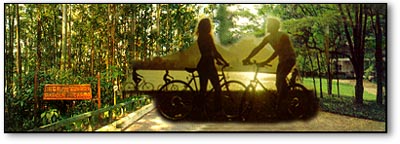 A proper
description of Sao Paulo's many attractions and activities would take
up more space than
we can devote here. Perhaps the best way to get acquainted with the city
upon arrival is to pick up a copy of the Sao Paulo edition of Veja Magazine--it
has a good English section
and will let you know Sao Paulo's happenings. What follows are just a few
of the major, permanent attractions. A proper
description of Sao Paulo's many attractions and activities would take
up more space than
we can devote here. Perhaps the best way to get acquainted with the city
upon arrival is to pick up a copy of the Sao Paulo edition of Veja Magazine--it
has a good English section
and will let you know Sao Paulo's happenings. What follows are just a few
of the major, permanent attractions.
The Museo de Arte Sacra & Jardim da Luz is deemed by many to constitute the best
collection of colonial art and artifacts in South America. The museum occupies a
labyrinthine baroque monastery built during the eighteenth century. This charming museum,
and the Jardim da Luz, are an unexpected center of tranquility. Visitors
should also take the opportunity to stop by the Sao Paulo Museum of Art (MASP),
which holds a
very good collection of both European and Brazilian art dating from antiquity
to the present.
 Many
visitors will make a beeline to the Butanta Institute, one of the world's
leading centers for the study of poisonous snakes. At the research
center, poisonous snakes are milked of their venom for serum. Although this
process is itself no longer open for
visitor observation, there is still plenty to see at this truly unusual place,
which holds tens of thousands of snakes. Many
visitors will make a beeline to the Butanta Institute, one of the world's
leading centers for the study of poisonous snakes. At the research
center, poisonous snakes are milked of their venom for serum. Although this
process is itself no longer open for
visitor observation, there is still plenty to see at this truly unusual place,
which holds tens of thousands of snakes.
There is great shopping in Sao Paulo's malls, but the weekend markets and
fairs are far more entertaining. At the Praca da Republica a fair runs from
8am to 2pm Sundays. People
watching is one of the most enjoyable aspects of any fair, but an array of
precious stones, leather, wood-carving, lace, paintings and more
also dazzle the eyes. Another great fair is the weekend fair in Embu, 12
miles from Sao Paulo. Artists display their wares, as well as craftsmen;
fine furniture is also one
reason so many go to the Embu fair.
The Parque do Ibirapuera, a large grassy area, is Sao Paulo's major public
park. Its
lake is a refreshing presence, and the park's monuments add a touch of solemnity.
But, the planetarium is what sets the park apart.
Soccer, Brazil's national sport, is big in Sao Paulo -which says a lot, considering
it is big everywhere in Brazil. To see a soccer game in Brazil is to see soccer as art -
no country brings so much joy and skill to the sport. Local games take
place at large stadiums like Pacaembu, Morumbi, and Parque Antartica.
Copyright
(c) 1998 interKnowledge Corp. All rights reserved.

|

